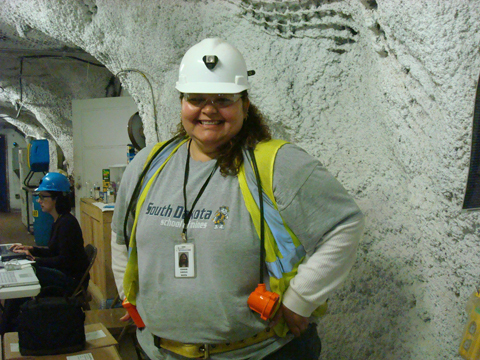
LEAD, SOUTH DAKOTA — On Saturday, July 9, Rosebud Sioux tribal member Connie Giroux donned a miner’s hardhat and lamp, safety glasses, battery belt, steel-toed boots, and a reflective vest. Then she took an elevator ride down a shaft through granite rock to a cavern 4,850 feet below the earth’s surface. It was not strange to her. She does it practically every day in her job as a supervisor at the Sanford Deep Underground Science and Engineering Laboratory (DUSEL). What made July 9 noteworthy is that her work was different because of Neutrino Day. She was conducting the first high-definition video conferencing from the depths with visitors up top who attended the fourth annual free science fair. Giroux could explain to them that her usual work is part of a pretty small crew of a privileged few who are conducting some pretty big world class experiments down there - most conspicuously in the Majorana Demonstrator Project and the Large Underground Xenon Detector (LUX). As a chapter closed in the international race for space last week with the scheduling of NASA’s last shuttle launch, a chapter opened in the comparatively new global race for the underground, in which Sanford lab is conducting the two experiments. One is to characterize neutrinos and the other is to prove the existence of so-called dark matter. Toward that end, contractors at the 4,850-foot level of the former Homestake Mine launched the latest phase of the Davis Underground Campus construction on June 20. They are busy outfitting an 11,500-square-foot grotto complex with the equipment to transform one of the dirtiest job sites possible – an old mine – into one of the most sparkling – a spotless experiment station. Deep underground science takes over where rocket science leaves off When they are done, the complex will be ready for installation of the Majorana Demonstrator Project and the LUX. Majorana researchers will try to isolate a form of radiation never before detected, called “neutrinoless double-beta decay,” which could help determine the mass of the elusive neutrino. Scientists want LUX so they can be the first to prove what most everybody else already believes: There’s a lot more matter in the universe than meets the eye. They suspect maybe five or six times more. Deep labs protect sensitive experiments from cosmic radiation. The laboratory space must be spanking clean to minimize other background radiation from particles that would interfere with detection efforts. Space race replaced by competition to describe neutrinos and prove dark matter exists The campus is named after Nobel prize-winning nuclear chemist Ray Davis, who installed a neutrino detector in Homestake Mine in 1965. He conducted decades of experiments on the sub-atomic particles produced by the sun. The research led to a significant change in the understanding of how the universe works. The new campus is expected to open a year from now. When it is ready, research teams not only will use the elevator to the existing station, but also will board an electric train for a ride in an ore car to and from the new facility. Meanwhile the existing station conjures an idea of what’s in store. A well-lit, whitewashed room that is certifiably 10 times more immaculate than a hospital operating room, it contrasts with the view through its windows of the surrounding dusty gray stope that is typical of a mine. Human figures completely sheathed in white laboratory suits, masks, hoods and slippers flit around kitchen-like counters, weighing and sorting glass beakers of copper ingots. They are carrying out an unprecedented caliber of electro-forming, producing the world’s purest copper, which in turn will be applied to shield a neutrino detector made from germanium (Ge). In order for researchers to arrive at this point in the experiments, miners and engineers have had to stabilize and retrofit the abandoned mine. They have dumped more than 18,000 tons of loose rock and they have pumped flood waters to some 150 feet below the campus level. Among experts who addressed the public in the buildup to Neutrino Day was South Dakota Space Grant Consortium Deputy Director Thomas Durkin. During a forum July 7, at The Roundhouse restaurant in Lead, he gave a talk about the end of the space shuttle program. The last launch was planned for the next day. Neutrino Day sponsors included the Sanford Underground Laboratory, South Dakota Public Broadcasting, the Lead Area Chamber of Commerce, Black Hills State University, South Dakota School of Mines & Technology, and South Dakota’s Dakota Digital Network. SDPB’s participation in Neutrino Day activities is supported by a grant from the John T. Vucurevich Foundation. (Talli Nauman is co-director of Journalism to Raise Environmental Awareness. Contact her at talli.nauman@gmail.com)
Join the Conversation